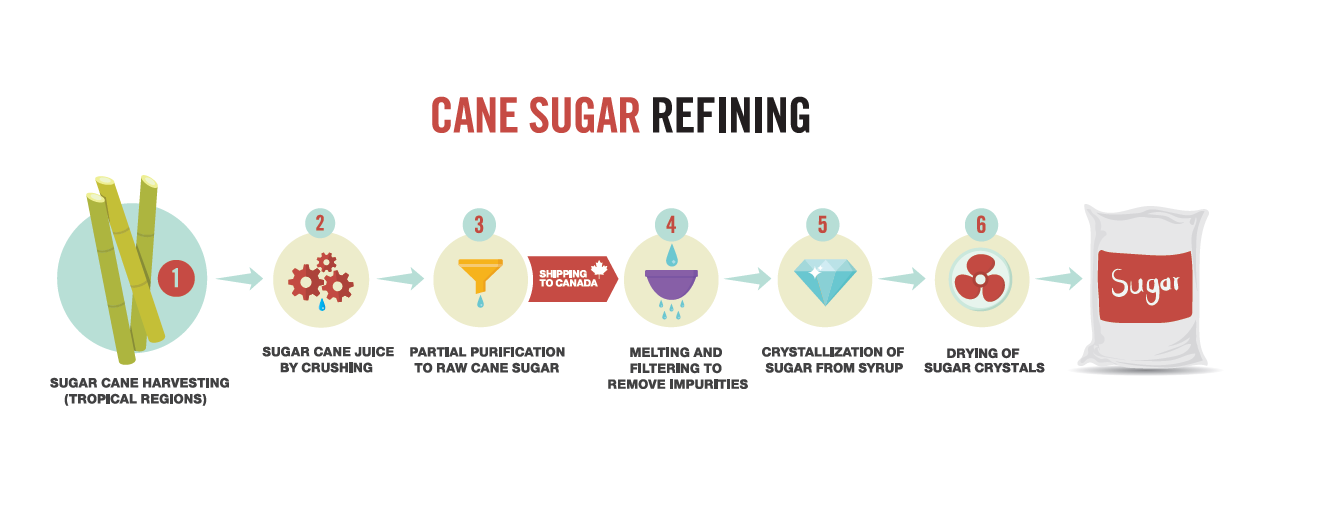
Main sugar cane producers include Brazil India China Mexico Australia Thailand Pakistan and the United States. However sugar cane can be processed in a lot simpler way requiring mostly just crushing of the canes and cooking the resulting syrups.

Farming crushing separating and drying.
How is cane sugar made. Sugar cane is harvested by chopping down the stems but leaving the roots so that it re-grows in time for the next crop. Harvest times tend to be during the dry season and the length of the harvest ranges from as little as 2 ½ months up to 11 months. Sugar cane is not grown in the EU.
Main sugar cane producers include Brazil India China Mexico Australia Thailand Pakistan and the United States. Raw sugar produced from cane contains brown syrup within its crystal structure. This makes it brown in colour.
Sugar is made in the leaves of the sugar cane plant by photosynthesis. Energy from the sun transforms carbon dioxide and water into oxygen and glucose. The excess energy which the plant doesnt need is stored as sugar in a sweet juice found in the plants fibrous stalks.
Ever wondered how sugar is made. Get the full history and making of right hereSubscribe to Discovery UK for more great clips. All green plants produce sugar sucrose through photosynthesis a natural process that turns sunlight into energy.
Sugar is harvested from sugar beets root vegetables that grow in cooler climates and sugar cane plants tropical grasses that grow up to 20 feet tall. How sugar is produced from sugar cane. The diagram displays how sugar is manufactured from sugar cane.
Overall it is a man-made linear process consisting of four main stages. Farming crushing separating and drying. The first step is to grow sugar cane and it takes about 12 to 18 months for it to mature.
Cane sugar has been the sweetener of choice for over 2000 years. It is used in all types of foods due to its versatility. It enhances flavor aroma texture.
White granulated sugar can come from either sugar cane Saccharum officinarum or sugar beets. Cane sugar is specifically the sugar made from sugar cane. Sugar comes from sugar canes as a sweet juice.
Sugar canes look like bamboo that can measure up to 6 m high. Machines are used to harvest the sugar canes from its base. The cut cane is then transported to the sugar mill for processing.
Bits of muck bugs that survived the fire cane fibers and plant extracts float in the sugar water. The fibrous remains of the stalk known as bagasse are recycled into animal feed bio-fuel and goods made from cane pulp. Even fashion and fabric designers have begun to adapt the leftovers.
After the cane is cut the stumps are left in the ground to start growing again. After two or three crops the ground is given a break to make sure it stays rich and ready to grow sugary-sweet sugar cane. But growing and harvesting the cane is just the beginning.
At the Sugar Mill. However sugar cane can be processed in a lot simpler way requiring mostly just crushing of the canes and cooking the resulting syrups. This is how jaggery and similar products are produced.
Since you just cook the syrup it contains a lot more different ingredients than refined sugar. According to the American Sugar Refining Group a sugar cane stalk is 72 water 12 sugar 13 fiber and 3 molasses. White granulated sugar is made by removing all of the molasses.
Brown sugar retains some of the molasses which gives it its darker color.